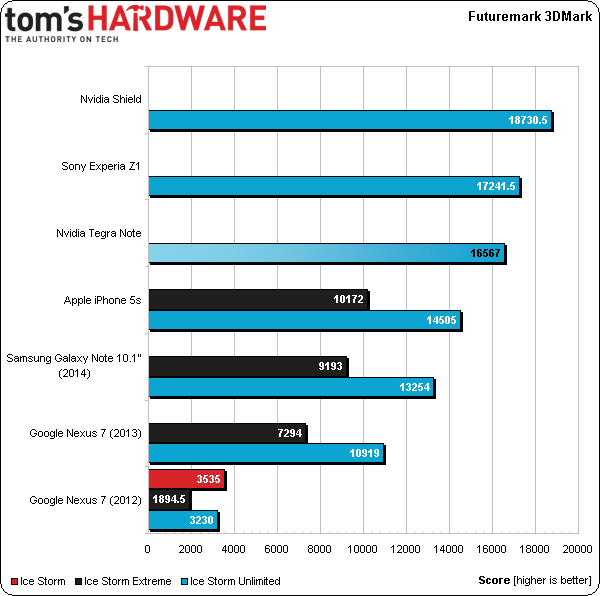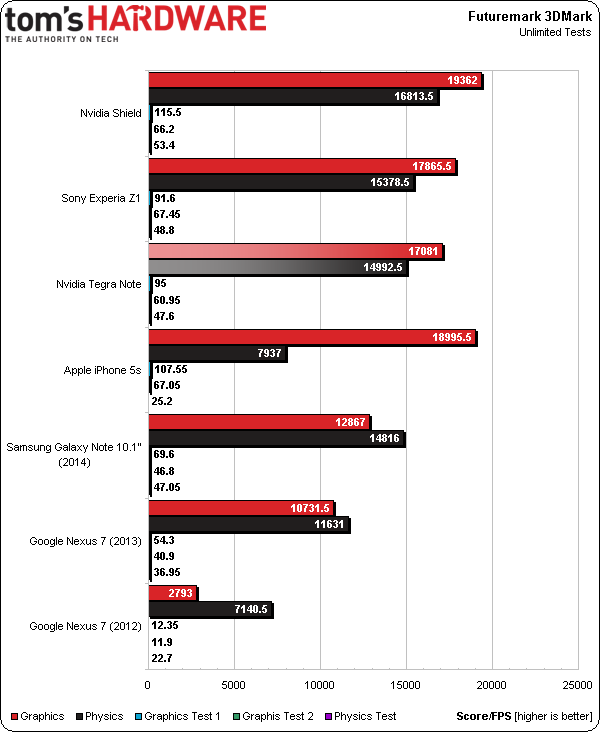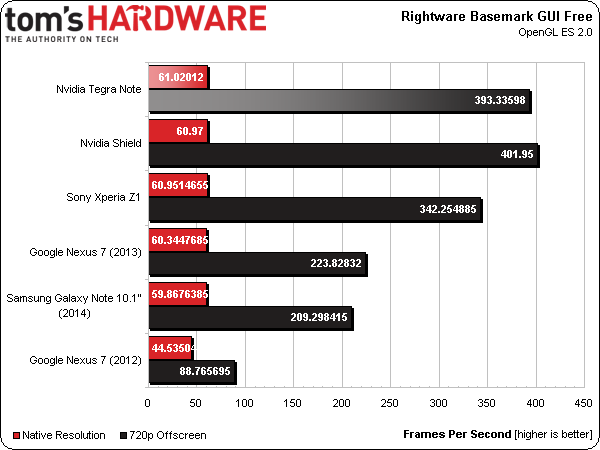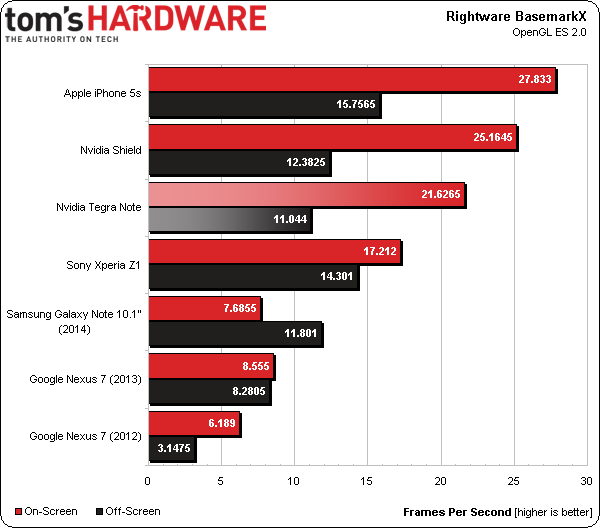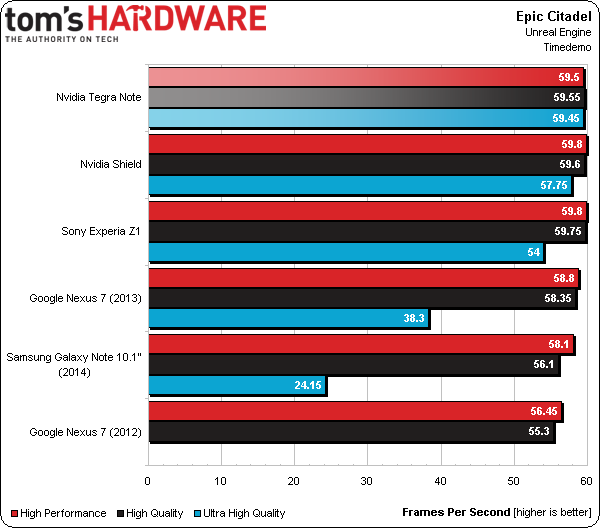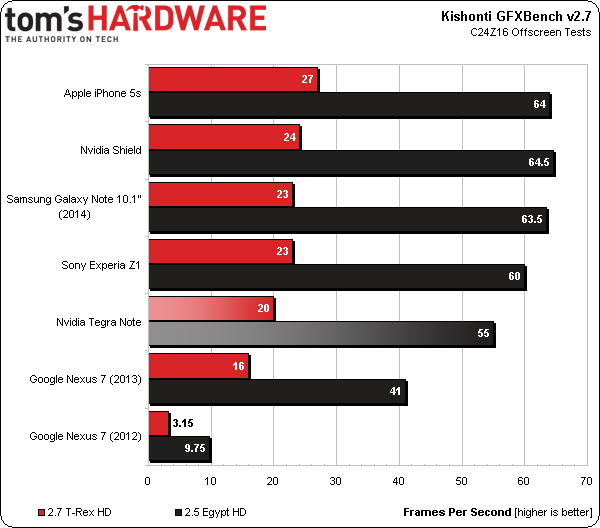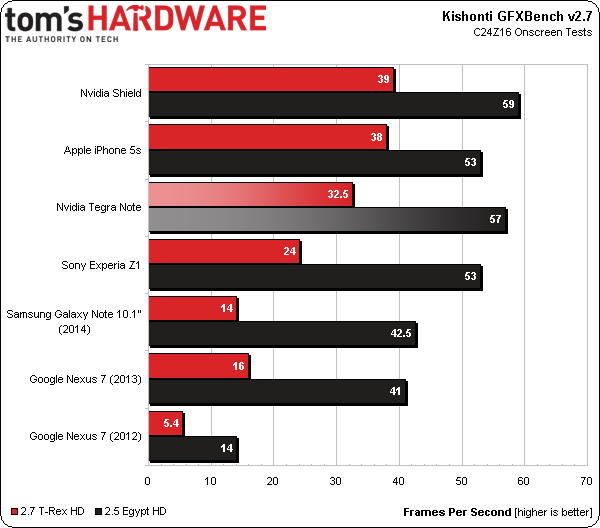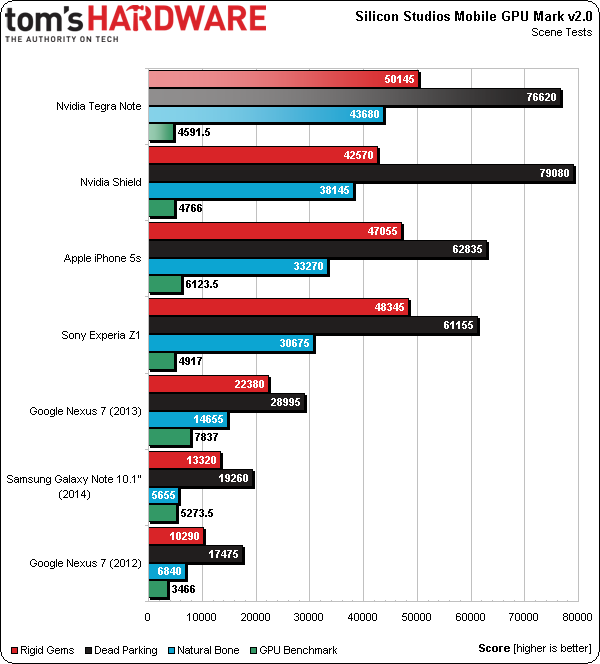EVGA Tegra Note 7 Review: Nvidia's Tegra 4 For $200
Nvidia is partnering with EVGA on the company's second Tegra 4-based device. Its Tegra Note 7 sells for $200, sports unique stylus technology, and ships with a bloatware-free build of Android. Can it set a new standard for affordable seven-inch tablets?
Results: GPU Benchmarks
3DMark
Futuremark is a name synonymous with benchmarking GPUs, and 3DMark for mobile has quickly become a very popular tool for doing just that. 3DMark offers three main graphical benchmarks, which simulate the demands of OpenGL ES 2.0 games using shaders, particles, and physics in Futuremark’s in-house engine. The first, Ice Storm, runs at a fixed 1280x720 off-screen resolution, while the second, Ice Storm Extreme, increases the resolution to 1920x1080. Finally, Ice Storm Unlimited renders the scene at native resolution. While it was just released in late May of this year, and is updated quite regularly, 3DMark is already being oustripped by more recent chipsets with Nvidia’s Tegra 4 and Qualcomm’s Snapdragon 800 Adreno 330 both maxing out the benchmark in Extreme (1080p) with ease.
Nvidia’s Shield, Sony’s Xperia Z1, and the Tegra Note all trounce the rest of the field, as each maxes out Ice Storm and Ice Storm Extreme. The iPhone 5s’s PowerVR Rogue-equipped A7 disappoints, considering that it tends to do so well in other GPU benchmarks. What’s really interesting is seeing just how far mobile GPUs have come. In a little over two years, Nvidia and its competitors have managed to more than triple GPU performance. As before, Tegra Note shows that it can run with the big dogs at a much cheaper price.
When we break down the Extreme tests, we easily see the Shield’s performance advantage over Tegra Note 7. Still, Tegra Note still stays in the top performance tier, which is very impressive. iPhone 5S performs inconsistently, scoring low on physics and high everywhere else. Futuremark went to some effort to investigate and discussed this on its blog.
Basemark GUI
Rightware is another benchmarking stalwart, and its Rightmark toolset is well known. Basemark is the company’s Android UI performance test. It’s designed to simulate the demands of intensive UI use in 3D (think applications like Google Maps). As with 3DMark, though, it is starting to be overshadowed by more modern SoCs and implementations of Android (since 4.1, more and more of Android’s UI is rendered in hardware).
In terms of native resolution on-screen performance, every device we’re testing performs well, with all but last year’s Nexus 7 going right up to their refresh rates. The real story, however, is 720p off-screen performance: Tegra Note and Shield perform roughly on-par, while both Snapdragon-equipped devices are slower than their Tegra 4 counterparts.
Basemark X
Basemark X is a multi-platform benchmark based on a real game engine, Unity 4.0. It uses many of Unity’s modern features via the OpenGL ES 2.0 render path, just as a modern game would. Features like high poly count models, shaders with normal maps, complex LoD algorithms, extensive per-pixel lighting including directional and point light, along with a comprehensive set of post process, particle systems, and physics effects test how a modern game might run and look. It’s an aggressive test that still isn’t being maxed out by the latest mobile SoCs.
Apple takes the lead, but with such low results all around, the Unity engine could be demonstrating some other platform bottleneck. The Tegra 4-based devices are once again on top of the Android-powered platforms (though Shield is the fastest of the two). Sony’s Xperia Z1 beats both Tegra 4 devices in off-screen performance, but suffers during the on-screen measurement due to its higher-resolution display.
Get Tom's Hardware's best news and in-depth reviews, straight to your inbox.
Epic Citadel
Epic’s Unreal Engine is put to decent use in this benchmark, which simulates a reasonably simple first-person game environment. It’s a little old as benchmarks go, easily maxed out in Performance and High Quality modes by even older SoCs like Tegra 3. Yet, it does use a real game engine and can be a strain in Ultra High Quality mode,
The Tegra Note and Shield are ever-so-close to each other. That the Xperia, Nexus 7 2013, and Galaxy Note 10.1 run slower in Ultra High Quality mode is of no real surprise, as each device has either a higher resolution display, a slightly slower GPU or, in the case of the Note 10.1, both!
GFXBench
Kishonti GFXBench 2.7 (previously known as GLBenchmark) is a cross-platform OpenGL GPU benchmark. It not only simulates scenes that a game might render, but also runs a series of additional tests that cover considerations like fill-rate, render accuracy, and so on. This is a demanding metric, especially the T-Rex scene because it uses many modern effects including motion blur, parallax mapping, and complex particle systems. We will only be concentrating on four main benchmarks in the suite: T-Rex HD Offscreen, Egypt HD Offscreen, T-Rex HD Onscreen, and Egypt HD Onscreen.
While it seems that performance scales almost linearly from Apple’s iPhone 5s to last year’s Nexus 7, the Tegra Note is actually almost 20% slower than Nvidia’s Shield in the T-Rex test and almost 15% slower in the Egypt test. Both of these tests are quite long and T-Rex is definitely demanding. Could Tegra 4 be slowing itself down in a way we weren’t seeing when we tried forcing it to throttle? Regardless, the Tegra Note 7 performs admirably, beating out the new Google Nexus 7 by around 30%.
Devices like the Shield, iPhone 5s, and Tegra Note with lower-resolution displays naturally perform best in our on-screen tests. Tegra Note scales to be 10% slower than Shield, and the higher-resolution devices are all made to suffer for their lush-looking screens. Again, though, the Tegra Note 7 demonstrates great value for its price.
Mobile GPUMark
Silicon Studios’ Mobile GPUMark is a benchmark that employs the company’s own in-house engine called YEBIS 2. It focuses on post-processing effects like color grading, bloom, and lenticular lighting to create filmic scenes.
Tegra Note 7 shows up at the top of our chart, despite having less RAM, a lower maximum clock rate, and utilizing passive cooling. It’s only beaten in one scene by Shield. Also interesting is that the Tegra Note beats Apple’s iPhone 5s easily in all but one test. Driving a 1280x800 screen, its 1 GB of DDR3L doesn’t seem to be a problem. As an aside, the Xperia Z1’s Adreno 330 engine seems to handle these complex scenes better than the Galaxy Note 10.1’s Mali, which even loses to the new Google Nexus 7’s Adreno 320.
Current page: Results: GPU Benchmarks
Prev Page Results: CPU Benchmarks Next Page Results: Web Browsing Benchmarks-
DelightfulDucklings Performance wise it is very good for the price seemingly but I just hate the design, to me it just looks plain uglyReply -
JD88 Front facing speakers are really nice. One of the very few complaints I have about my Nexus 7 is volume.Reply
This thing is a powerhouse for the money. -
ananke No 1080p, no sales. Otherwise great device, and good price, but DOA because of the screen. The Chinese knock offs will outsell it.Reply -
TheSchmed I am considering buying this tablet, but I'm weighing it against the less-expensive Dell Venue 7 and 8 (Android, not W8). I hope Tom's will review the Dell tablets and evaluate Intel processor performance and battery life!Reply -
somebodyspecial CF BENCH:Reply
"Sony has been optimising for Snapdragon-based devices since the Xperia range took on the Krait core, and its experience shows as the Xperia Z1 comfortably leads the Tegra Note and Galaxy Note 10.1 in both Managed and Native."
xperia java=32352
Tegra Note7=32648.5
Unless I'm not understanding what is going on here, 32648 is the longer bar/better score right? So while it lost NATIVE, it did not lose Java Managed right? It seems Sony won NATIVE and TEGRA note 7 won Java Managed. You need to fix the text. -
Lessthannil Why does everyone complain about no 1080p? The difference between 1280x800 to 1920X1080p on a 7" screen is minimal while it requires signifigantly more performance and power. Also, its a $199 tablet, what where you expecting?Reply -
JeanLuc While benchmarking did you check to see if the any of the devices you were testing were boosting the SOC clock rates beyond the advertised clock speeds in certain benchmarks? Anandtech looked at this issue a while ago, it would be good to see publications like Toms testing for this sorting of thing and name and shame culprits.Reply -
somebodyspecial Shows the power of the T4, I just wish they'd put it in something I want. And I agree 1080p min on anything that is above a phone' 5in size. But I also understand some just don't care so really a personally complaint about that. I'll wait for T5 and hope they get it into 1080/1200p on 13in or 20in ;) I have no use for 10 or below after using nexus10. Print etc, stuff is just too dang small. Maybe spoiled by 24in/22in dual monitors. I just can do squat on something that small and enjoy it other than some games and I'm not even sure about that. I hope they make a 7in shield 2 :) (maybe a 10in?...LOL).Reply
Smaller and THINNER (you took how much of my batter for thinner?) are USELESS to me. Give me back that larger and FAT model please, so I can run with more power or longer life (or some combo of both). As soon as I see "THINNER" in any description I just put my wallet back and shake my head :( Did I want thinner 10-15 years ago, yeah...Now that party ended ages ago for me.
